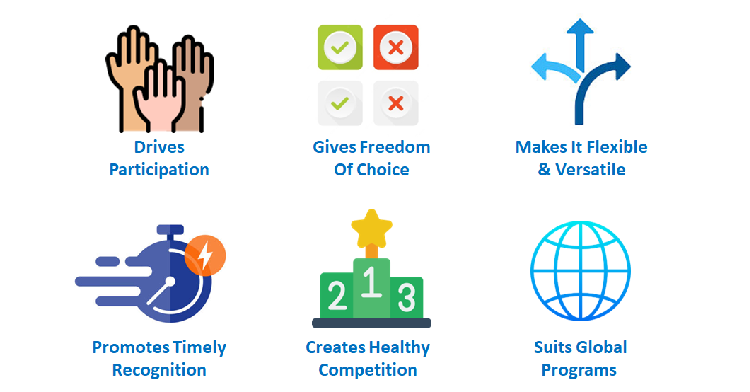1. A points-based employee rewards and recognition system is highly effective because it incorporates gamification, which drives employee engagement and motivation.
2. Employees earn points for significant contributions, which they can later redeem for rewards, providing flexibility and personalization.
3. This system promotes healthy competition, transparency, and regular recognition, making it suitable for global organizations.
4. Clear policies, diverse redemption options, and regular communication are essential for maximizing benefits and ensuring the system is easy to understand and engaging for employees.
In recent years, organizations have recognized the importance of incorporating gamification elements, such as reward points, into their employee reward programs to enhance their effectiveness. In this context, let’s explore why the points-based system is most effective for employee rewards and recognition.

In the points-based reward system, employees are awarded points every time they do something significant that contributes to the business’s growth and success.
Employees accumulate points awarded over a period and redeem them to receive predetermined benefits, such as gift cards, merchandise, or cash.

These points act as a workplace currency that employees can earn and use.
Employees can accumulate points over a period and redeem them as needed, making the program more flexible and adaptable.
A points-based reward system offers great benefits for organizations. The overachievements of employees on their key performance indicators can be easily calibrated and rewarded in the form of points.
It gives employees an immediate sense of achievement and instant gratification when they earn these points, motivating them to work harder to earn more.

However, organizations need to define clear policies around them to maximize the benefits of a points-based employee rewards system.
They need to clearly communicate to employees the criteria for earning these points and also the number of points that would be rewarded.
Organizations must also inform employees about how they can redeem their points and the different redemption options available.

An AI and digital transformation company headquartered in the US is leveraging the HiFives platform to run its employee rewards and recognition program for its global workforce. It uses a points-based system calibrated for different types of awards and various regions.
These include service awards, spot awards, value awards, and quarterly and bi-annual awards. Employees can earn reward points from various awards on the platform and redeem them for gift cards from brands specific to their region.
The HiFives platform displays the names of employees who have earned the highest points on the leaderboard. It encourages healthy competition among co-workers to perform better and earn more points.
A well-developed points-based rewards and recognition program can contribute significantly to the organization.
It can boost workforce productivity, improve employee retention, and promote a positive work culture.
It makes them extremely popular and widely used by organizations in employee rewards and recognition programs.
Here are the key benefits of such a rewards program:
1. Drives Employee Engagement And Participation
2. Provides Freedom Of Choice
3. Is Extremely Flexible And Versatile
4. Promotes Timely And Regular Recognition
5. Boosts Transparency And Healthy Competition
6. Suitable For Global Rewards Programs


Reward points add an element of gamification to the employee rewards and recognition program.
Hence, receiving them makes the employees feel motivated and engaged.
Earning points for meeting demanding deadlines or challenges gives employees a sense of achievement, like playing a game.
The zeal to earn more reward points motivates the employees to improve their performance and productivity.
The points system offers a game-like experience that attracts the younger segment of the workforce (especially millennials) and drives participation.

The points system acts as a currency for employee rewards and can be calibrated based on different performance criteria and levels. It offers employees a system to accumulate points from different rewards and redeem them as they wish.
Employees can redeem these points for a wide selection of gift cards and merchandise, offering them a choice of options.
They do need to accept specific reward items, unlike traditional reward systems.

One of the biggest benefits offered by a point-based recognition system is that it is extremely flexible and versatile.
It makes it easy to modify the program by recalibrating the points system with the different levels of rewards and recognition.
It can help meet the changing needs of the organization and its employees.

Organizations understand the importance of recognizing their employees instantly and regularly quite well. A point-based system, integrated with an efficient employee recognition platform can help organizations achieve this objective easily.
With a points-based system, employees can be rewarded on the spot by their managers for demonstrating exemplary performance.
The organization can award them with a relatively small number of points.
Employees can accumulate these points over time as they receive multiple awards. They can eventually redeem them for something of their choice.

A points-based system makes the entire rewards and recognition program very transparent and trackable.
Employees can quickly determine their standing vis-à-vis their peers within the organization.
Their managers and HR can also track their progress and intervene as needed.
Other gamification elements, such as timelines and leaderboards, create healthy competition among coworkers.
They strive to work harder and perform better to earn more reward points.

Most organizations today have a global workforce, spread across multiple countries. Organizations can consolidate their employee rewards programs and run a single points-based rewards system.
A point-based reward system can enable employees to earn reward points and redeem them for local options in local currencies.
It streamlines the entire process of employee rewards globally.

A global tech company with over 5,000 employees across 25 countries, including the United States, Canada, the United Kingdom, the Netherlands, and India, utilizes the HiFives platform to manage its employee rewards and recognition program.
The program incorporates both monetary and non-monetary recognition initiated by peers and managers. Employees also receive rewards and recognition for learning and development, innovation, and other organizational activities.
Employees who receive monetary recognition are credited with reward points on the HiFives platform. The financial value of the reward points depends on the country where they are located and is determined by the country’s purchasing power parity (PPP). Based on the converted value, they can redeem these points for e-gift cards of brands specific to their country.

The HiFives platform, with its reward points and global redemption model, has enabled the company to run a single rewards and recognition program worldwide, providing employees with preferred redemption options wherever they are. Managing dozens of regional employee rewards programs in the past was a significant challenge for the HR team.
An effective points-based employee rewards and recognition system can help promote desirable behaviors, reinforce organizational values, and achieve business objectives.
However, organizations need to incorporate certain best practices to make the points-based reward systems work effectively for them.
Here are the top 5 best practices that they need to follow:
1. Define A Clear Policy For Earning Points
2. Provide Great Options For Redeeming Points
3. Leverage A Robust Digital Platform
4. Focus On Employee Experience
5. Communicate Regularly


The organization should define the points system for employee rewards clearly. They should lay down the criteria for each award and the number of points associated with each of them.
The organization should also state the monetary value of each reward in the local currency without any ambiguity.
If the points have a limited validity, the organization should communicate that upfront.
Employees should be aware of the duration for which they can accumulate points and when to redeem them. Overall, the rules of the game should be unambiguous!

Earning reward points is just half of the gratification that employees can experience. Redemption is the other half.
The points system must be backed by a wide choice of meaningful and exciting redemption options.
These could include various gift cards and merchandise of different types and brands.
These options should align with the employee’s location and profile.

An effective employee rewards and recognition platform is the backbone of a good points-based rewards system. The platform enables employees to earn and redeem points easily.
It sends out notifications and alerts them at different stages of the recognition process.
The platform also helps them track their earning and redemption histories and check their balances in real time.
Other gamification features such as digital badges, timelines, walls, and leaderboards are important features that should be included in the digital platform used.
Integration with other platforms, such as HRMS, MS Teams, Slack, and mobile apps, enables easy single sign-on access.

Organizations should focus on enhancing employee experience and maximizing engagement through point-based rewards.
They must ensure the system is uncomplicated and easy to understand for employees and their managers.
It should also generate high interest, excitement, and employee engagement.
The user interface and navigation should be user-friendly, intuitive, and engaging. Overall, the points-based system should attract employees to use it and drive participation.

It is equally crucial for the organization to communicate regularly about the program.
Such communication should include highlights, updates on new features, policy changes, and other relevant information.
Regular communication serves as a reminder for the employees to participate in the program. It also helps them to stay updated on the rules of the game.
A points-based rewards system can help gamify an employee rewards and recognition program effectively. This, in turn, makes the whole experience interesting and attractive for the employees, improving the participation rate and making the program more impactful.
It is why a points-based system works best for employee rewards and recognition, and is becoming increasingly popular among organizations.

Lead author: Sagar Chaudhuri, the Co-Founder and CEO of HiFives. He is an HR Tech Evangelist with over 25 years of experience in both corporate and entrepreneurial settings. Previously, Sagar has held leadership roles with companies such as Genpact, Infosys, and ICICI Bank. He has an engineering degree from IIT Kharagpur and an MBA from IIM Lucknow. Connect on LinkedIn
To stay updated on the latest HiFives blogs, follow us on Twitter (@MyHiFives)